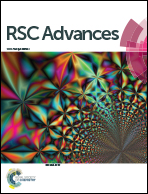Studies of structural diversity due to inter-/intra-molecular hydrogen bonding and photoluminescent properties in thiocarboxylate Cu(i) and Ag(i) complexes†
Abstract
Seven new copper(I) thiocarboxylate and two silver thiocarboxylate complexes, containing 2-mercaptobenzimidazole (MB) and 2-mercapto-2-thiazoline (MT) have been synthesized and characterized by elemental analysis, IR, 1H NMR, 13C NMR and UV-Visible spectroscopic techniques. Molecular structures of all the complexes have been examined by single crystal X-ray diffraction analysis. In the case of complexes 1 ([(PPh3)2Cu(SCOMe)MB]) and 3 ([(PPh3)2Cu(SCOth)MB]), the direction of hydrogen bonding is changed from intra-molecular to inter-molecular by increasing the size of the R-group of the thiocarboxylate ligands. 7 ([Cu2(μ-SCOPh)2(μ-MT)(MT)]2) is a tetranuclear complex in which the distance between the two copper atoms is shorter than the sum of the covalent radii of the two atoms without having a formal covalent bond between them, as evidenced by NBO (DFT) calculation and bond critical point calculations using the AIM theory. In complex 8 two different molecules, [(PPh3)2Ag(SCOPh)MT] and [(PPh3)2Ag(SCOPh)] co-crystallized in the same lattice. The unit cell of complex 9 also possesses two structurally different molecules with the same molecular formula. Emission spectra of the complexes have been studied in both solution and solid states. Electronic spectral behaviors of the complexes 1 and 7 have been explained by TDDFT calculations.


 Please wait while we load your content...
Please wait while we load your content...